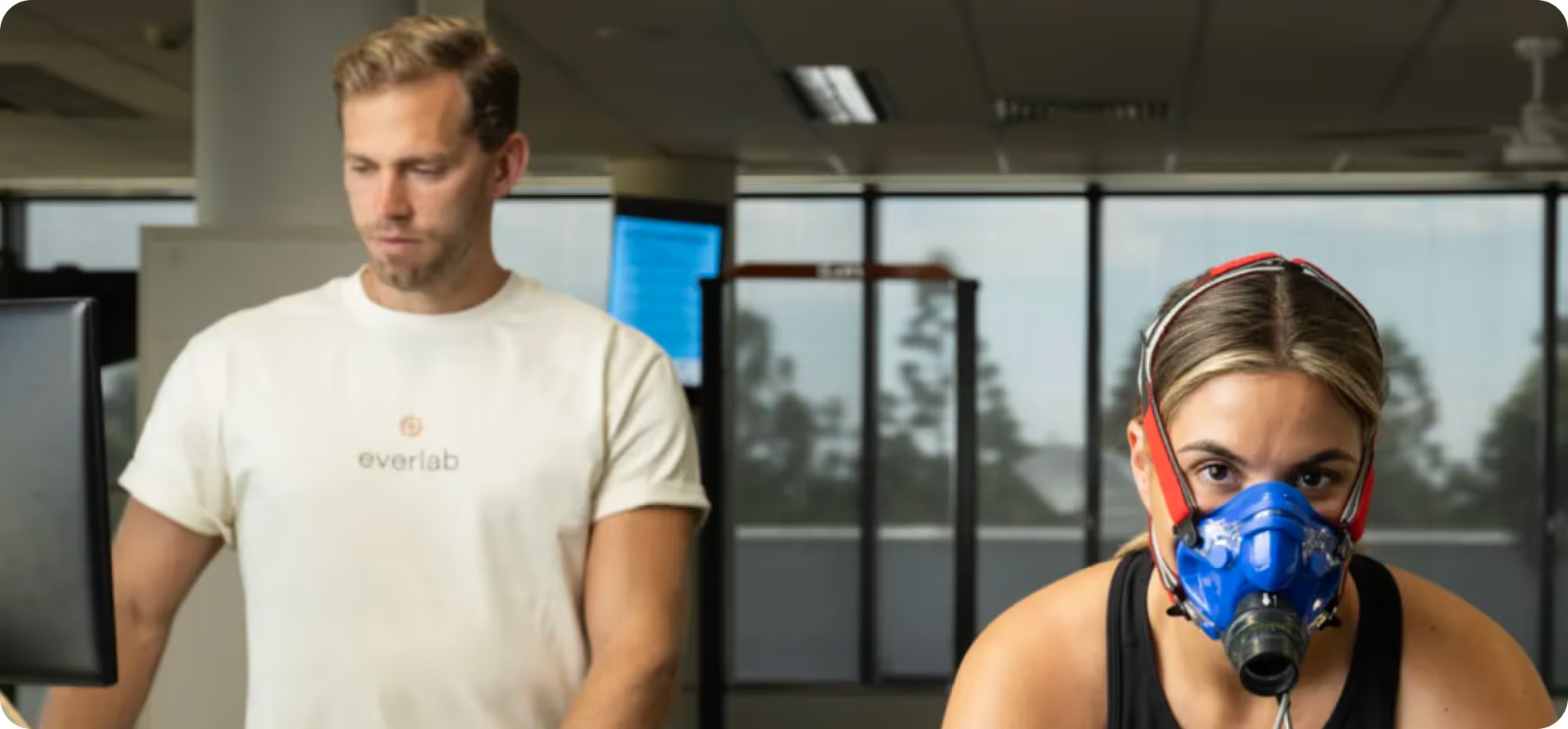VO₂ Max Testing In Australia
The VO₂ Max test is an essential tool for optimising fitness by measuring the maximum oxygen your body can use during intense exercise. It provides valuable insights into your cardiovascular endurance, helping you tailor your training for better performance. At Everlab, we use advanced technology for precise VO₂ Max testing in Australia, helping you unlock your body's true potential. Book your VO₂ test now and start improving your endurance today!

VO2 Max Test: Key indicator of cardiovascular fitness. Book Now!
What:
Measures your body's maximum oxygen use during intense exercise
Tests for:
Aerobic capacity & cardiovascular fitness
Referral:
Not required
Member cost:
Part of Everlab program
Overview: VO₂ Max Test
What is VO₂ Max?
VO₂ Max is a measure of cardiorespiratory fitness. It calculates oxygen intake and distribution throughout the body. It's an objective measure of fitness during an incremental exercise test, typically involving running or cycling.
Why does VO₂ Max matter?
VO₂ Max is considered the gold standard for measuring cardiorespiratory fitness, and it is one of the strongest indicators of long-term health.
Higher VO₂ Max is linked to a significantly lower risk of disease and early death. For every 10-point increase in VO₂ Max, there is a 17 per cent lower risk of death from cancer and an 11 percent reduction in overall mortality. Improving your VO₂ Max is not just about athletic performance—it is one of the most powerful ways to protect your long-term health.
But it is not just the number that matters—it is what you do with it.
By testing your VO₂ Max, you get a clear understanding of your current fitness capacity—how efficiently your body takes in and uses oxygen during exercise. This gives you a baseline to track progress and make informed changes to your training.
You also unlock your personalised training zones, including your Zone 2 heart rate—a key range for building endurance and improving metabolic health—and your lactate threshold, which helps you identify the intensity at which fatigue sets in. These insights help you train smarter, not harder. You will know exactly how hard to push and when to pull back.
Most importantly, VO₂ Max testing highlights your physiological strengths and weaknesses. Maybe your aerobic engine is strong, but your recovery is slow. Or maybe you have the speed, but not the stamina. We give you clear, actionable strategies to turn those weak points into progress, whether that is adjusting your training mix, recovery, or nutrition.
At Everlab, VO₂ Max testing gives you more than a number. It gives you a personal roadmap to better fitness, smarter training, and stronger health outcomes.
VO₂ Max Test Requirements
Medical clearance is required for VO₂ Max testing if you are male or female and over 35 years of age. This is a safety measure to ensure your heart and lungs are in a suitable condition for high-intensity testing. If a health issue is identified during screening, you may need to undergo additional assessments or clearance before proceeding with the test or your consultation.
To get the most accurate and meaningful results, it is important to follow a few simple preparation steps.
- Dress appropriately: Wear comfortable exercise clothing that allows you to move freely. Bring your running shoes, a small towel, and a water bottle—you’ll be working hard, so come ready to sweat.
- Be well-rested and hydrated: Arrive fresh, well hydrated, and ready to exercise at your maximum capacity. Avoid any strenuous exercise in the 24 hours before your test, as fatigue can reduce your performance and skew your results.
- Watch your nutrition: Avoid eating large meals 2 to 3 hours before your test. Instead, treat it like race day—use foods and timing you know your body responds well to. Poor fuelling or mistimed meals can limit your ability to hit true max effort.
- Be consistent for follow-up testing: If you plan to retest in the future to track your progress, aim to schedule your session at the same time of day and follow the same preparation steps. This consistency ensures reliable comparisons over time and a clearer picture of your improvement.
Preparing well sets you up for accurate results, safer testing, and a better understanding of your fitness. Our team will guide you through each step so you can get the most from your VO₂ Max test.
Next Step After VO₂ Max Test
Getting your VO₂ Max tested is the first step. What you do with that information is where the real progress happens.
After the test, you’ll receive a full report including your Zone 2 heart rate, lactate threshold, and VO₂ Max score. These numbers aren't just for reference—they’re the blueprint for smarter, more effective training. Whether you're training for endurance, performance, or general fitness, using these zones will help you train at the right intensity, avoid burnout, and make faster gains.
Your Zone 2 heart rate helps you build aerobic endurance and improve metabolic health without pushing too hard. Your lactate threshold tells you the point where fatigue begins to set in—pushing this number higher improves performance across all intensities.
To see improvement, consistency is key. We recommend retesting every 6 months to track your fitness progress and update your training zones. As your body adapts, your thresholds will change, and your training should too.
For serious results, consider our multi-test package, which gives you access to year-round performance monitoring. It’s the easiest way to keep your training aligned with your goals and make data-driven decisions every step of the way.
Results & Follow Up
What should my VO₂ Max be by age?
Below, we’ve attached a picture of the percentiles for VO₂ Max by gender and age group. A good VO₂ Max for your age is in the high or elite categories. VO₂ Max is expressed relative to body weight, indicating that a person's fitness level can be influenced by factors such as body fat and overall mass, making it a crucial metric for athletes and those looking to improve their physical health.
%2525201.avif)
What is a VO₂ Max Report?
The type of report you will receive after completing your VO₂ Max will depend on the brand of the machine used. Almost always, the report will include your VO₂ Max measured in ML/kg/min and your heart rate levels in zones 1 to 5. The report may also include your lactate threshold heart rate as part of the assessment. Below is an example from the Cardio Coach VO₂ Max machine.
%2525202.avif)
Interpreting your results
Interpreting VO₂ max test results involves understanding what the values represent in terms of cardiovascular fitness and comparing them to normative data for age, gender, and fitness levels. Here’s how to interpret your results:
A higher VO₂ max indicates better aerobic fitness, as your body is more efficient at using oxygen to generate energy. A higher VO₂ max also allows for more energy production and reduced fatigue during exercise.
Heart Rate Zones
VO₂ max heart rate zones are a way of organising your training intensity based on your VO₂ max and heart rate. These zones help guide workouts to improve specific aspects of fitness, from endurance to speed, by targeting different energy systems in the body. The heart rate zones are expressed as percentages of your maximum heart rate (HRmax), and each zone has a distinct purpose in a training program. Understanding your lactate threshold heart rate can inform training recommendations and improve aerobic fitness.
- Zone #1: This is a low-intensity zone where your body primarily burns fat for energy. It’s used for easy, low-effort activities like walking or light jogging. Used after intense workouts or on rest days to help promote circulation and recovery without taxing the cardiovascular system.
- Zone #2: This is a moderate-intensity zone where your body still uses fat as a primary fuel source but starts tapping into carbohydrates. It’s sustainable for long periods and is ideal for base endurance training. Often used in long-distance running, cycling, or swimming for endurance athletes.
- Zone #3: In this zone, intensity picks up, and your body shifts more toward carbohydrate metabolism. It’s challenging but sustainable for a shorter period compared to Zone 2. Used in tempo runs, threshold training, and efforts lasting 20-60 minutes
- Zone #4: In this high-intensity zone, you start producing lactic acid faster than your body can clear it, leading to fatigue. You can only sustain efforts in this zone for short bursts of time.
- Zone #5: This is the highest-intensity zone, where you are working at or near your maximum capacity. Your body relies almost entirely on carbohydrate stores for energy, and oxygen consumption is at its peak. Typically used in high-intensity interval training (HIIT) sessions, sprint intervals, or maximum effort workouts. Sessions in this zone are short (usually less than 4 minutes) due to the high intensity.
Typically, training in zones 2 and 5 is most optimal for improving your VO₂ Max.
Risks and Considerations
What are the risks of doing a VO₂ Max test?
There are mild risks when completing a VO₂ Max test. These include cardiovascular stress, respiratory issues, muscle strain/injury, dizziness or fainting and general discomfort. These risks are generally low for healthy individuals but can be higher for those with pre-existing health conditions. It’s important to have the test supervised by trained professionals who can monitor for any adverse effects. Additionally, exercising during the test can lead to various physiological responses such as lactate production and changes in oxygen consumption.
A consent form should be filled out before completing the tests, including the following questions:
- Do you ever experience unexplained pains or discomfort in your chest at rest or during physical activity/exercise?
- Do you ever feel faint, dizzy or lose balance during physical activity/exercise?
- Have you had an asthma attack requiring immediate medical attention at any time over the last 12 months?
If the answer is yes to any of the above, it is best to speak with your doctor before completing the test.
Sources
- Physio-pedia – VO₂ Max
Overview of VO₂ Max, its physiological basis, testing protocols, and clinical significance.
https://www.physio-pedia.com/VO2_Max - American Heart Association – Physical Activity and Your Heart
Discusses the relationship between cardiovascular fitness, VO₂ Max, and long-term heart health.
https://www.heart.org/en/healthy-living/fitness/fitness-basics/target-heart-rates - PubMed – Cardiorespiratory Fitness and Mortality
Key study: “Cardiorespiratory fitness as a quantitative predictor of all-cause mortality and cardiovascular events.”
https://pubmed.ncbi.nlm.nih.gov/19454641/ - NIH – National Library of Medicine: VO₂ Max Testing and Interpretation
Research-based clinical explanation of VO₂ Max, testing standards, and health implications.
https://www.ncbi.nlm.nih.gov/books/NBK555956/
Why should you get a VO₂ Max Test?
As we age, inevitably our VO₂ Max declines. The higher the base today, the higher your VO₂ Max will be when you get older. Once you know your current results there are clear protocols available to improve and ensure your long term health. Explore an Everlab membership if you wish to learn more about and improve your VO₂ Max level.
